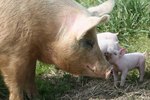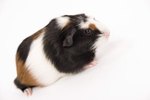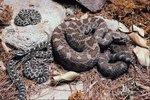
Hamsters reproduce at an astonishing rate: They're capable of producing litters as frequently as monthly. Hamsters can breed at just 3 weeks of age, which means your knowledgeable action is necessary to separate pups from their mother and put them into gender-specific housing groups as soon as they are weaned. Failure to do this can result in lots of unwanted hamster babies in a couple fortnights.
Hamster Litters
A typical female hamster can give birth to as many as 20 pups in a litter, though six to 12 is average. The mother will nurse and care for her babies the first two to three weeks of life, after which they will be able to transition to a commercial hamster diet. During this time , a mother hamster should be well-fed and hydrated, and kept in a quiet, low-stress environment. Anxious, underfed hamster mothers may otherwise kill their young.
Weaning
A mother hamster will start weaning her babies at 2 to 3 weeks of age. This time frame many vary based on how many pups are in the litter and how well individual pups are thriving. Pups may continue to try to nurse during this period but will be discouraged by their mother once they begin to reach maturity. Provide an adequate supply of food for the young hamsters during this time to make the transition easier.
Removing the Pups
You can remove weaned hamsters from their mother at approximately 3 to 4 weeks of age, though if a litter has exceptionally small hamsters or babies that failed to flourish, let them stay with their mother an extra week. Baby hamsters can safely go to adoptive homes as early as 3 weeks of age. It's preferable to adopt them out before they are 7 weeks old. Dwarf litter mates of the same sex do well together when kept in pairs. Litter mates of opposite genders will quickly reproduce if housed together, and other breeds may fight as they become mature.
Sexing Hamsters
Some breeds of hamsters, particularly dwarf varieties, are difficult to tell apart from a gender perspective when they are young, but you have to distinguish and separate males from females to avoid unintentional breeding. Hamsters have two distinctive openings on their undersides adjacent to their tails. In males, the openings are slightly apart, while in females the openings are close together.
Ongoing Breeding
A hamster mother is fertile and available for mating immediately after giving birth. For this reason, if you don’t want more hamsters, remove the father from the mother’s cage before pups are born, or immediately thereafter, if the pups were a surprise. A mother who immediately becomes pregnant after giving birth runs the risk of being malnourished while she nurses her current litter. In addition to the potential for breeding, a father hamster left in a cage with a mother and newborn pups may kill the baby hamsters in an effort to get the mother’s full attention.
References
Photo Credits
-
Small hamsters image by Vedmochka from Fotolia.com
Writer Bio
Lisa McQuerrey has been a business writer since 1987. In 1994, she launched a full-service marketing and communications firm. McQuerrey's work has garnered awards from the U.S. Small Business Administration, the International Association of Business Communicators and the Associated Press. She is also the author of several nonfiction trade publications, and, in 2012, had her first young-adult novel published by Glass Page Books.




